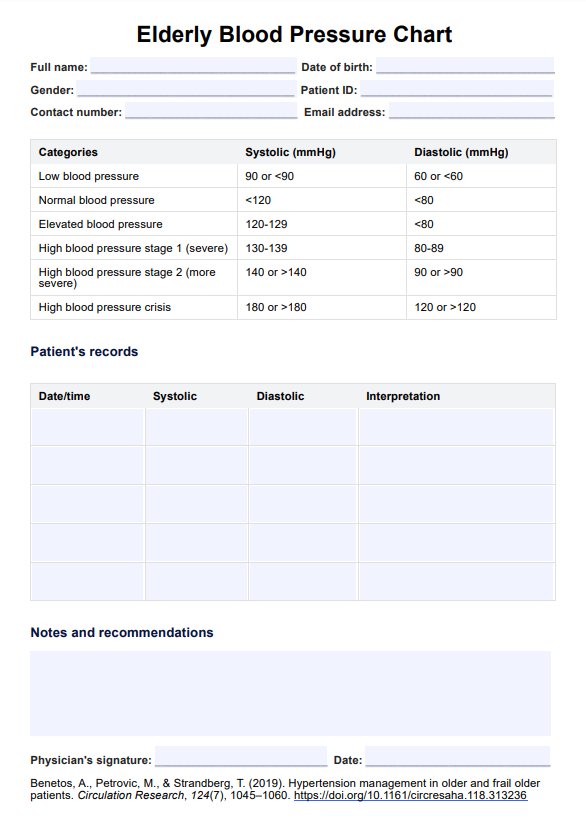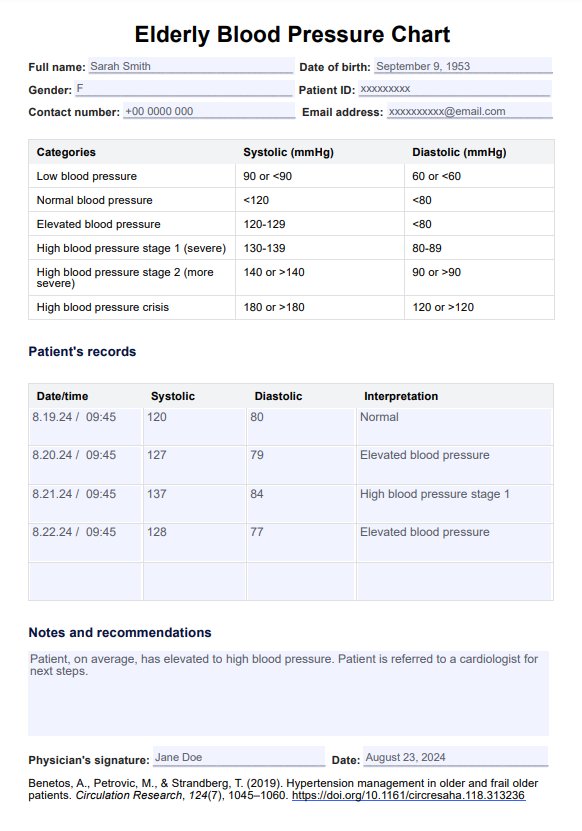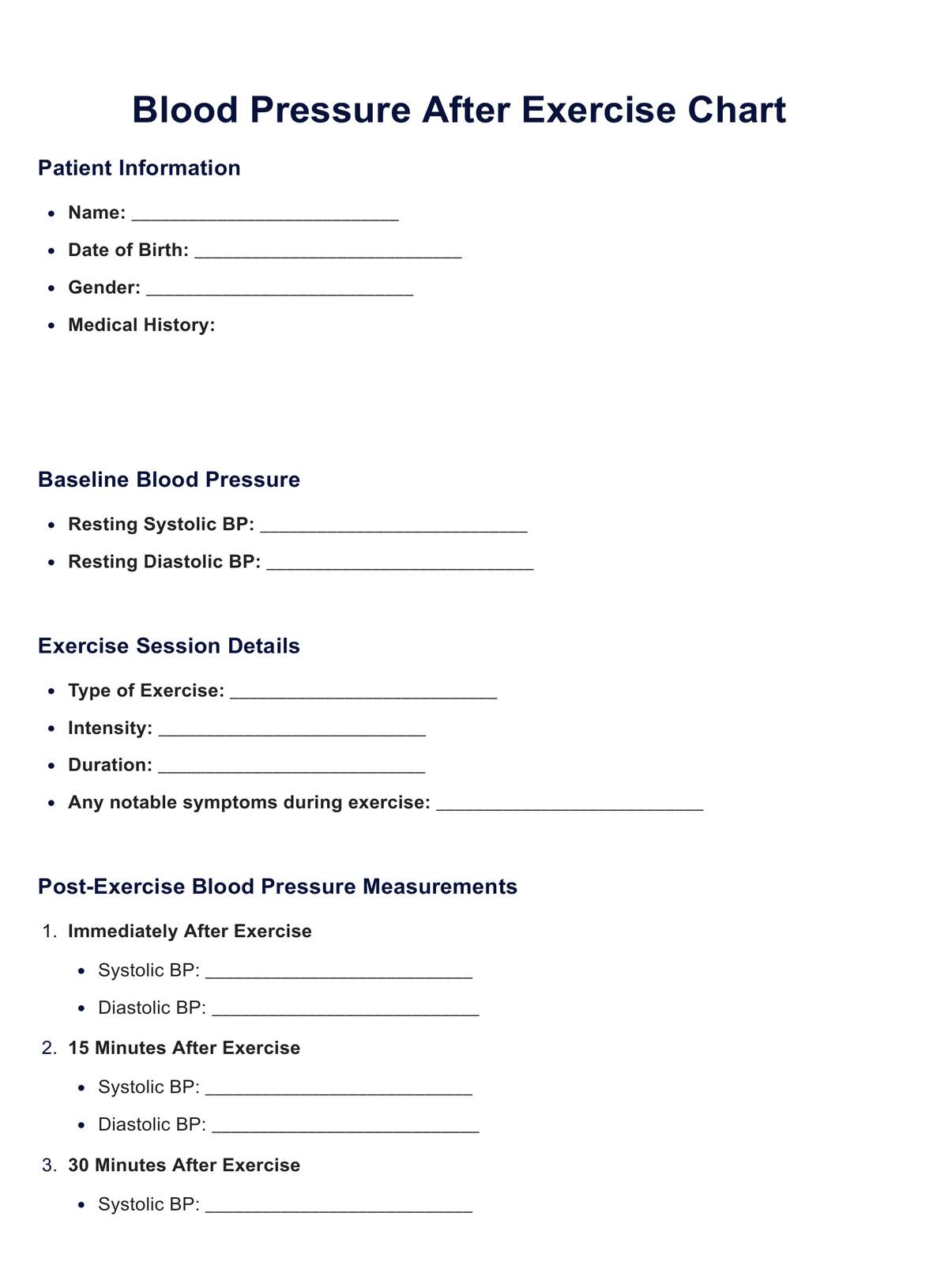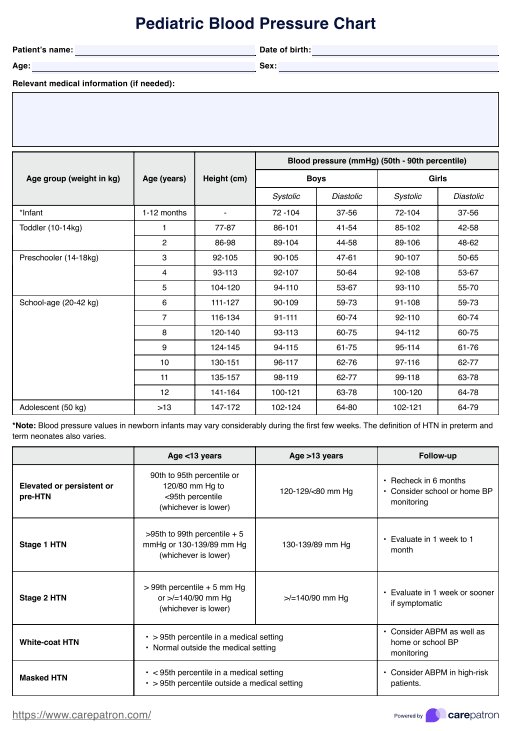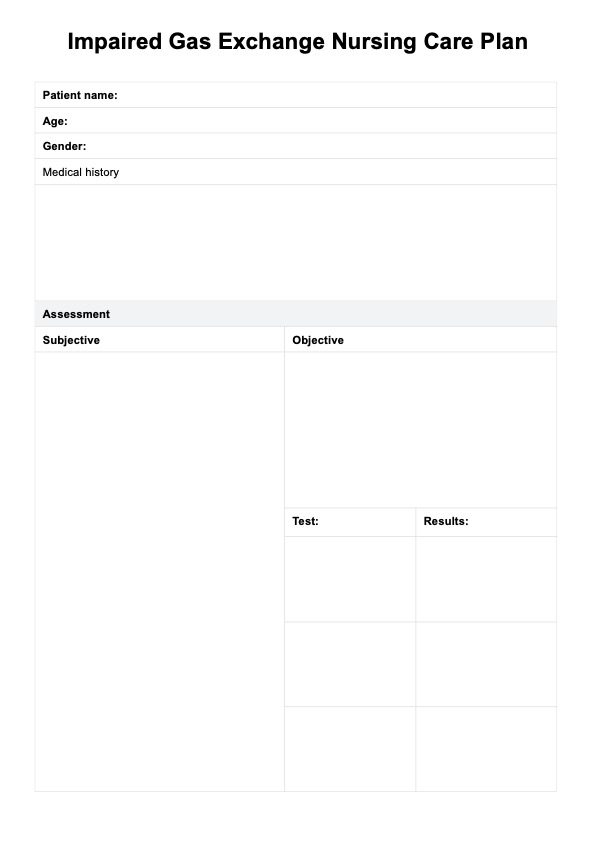Elderly Blood Pressure Chart
Get access to a free Elderly Blood Pressure Chart and example. Streamline your practice with this resource from Carepatron.


Understanding blood pressure
Blood pressure is the force exerted by the blood against the walls of the arteries as it circulates through the body. This process involves heart and blood vessels and is typically measured using two numbers. The number representing how much pressure is exerted when the heart contracts is called systolic blood pressure. On the other hand, the rate of pressure when the heart relaxes between beats is called diastolic blood pressure.
As individuals age, their blood vessels tend to become less elastic, leading to an increased risk of elevated blood pressure, also known as hypertension (Centers for Disease Control and Prevention, 2024). Hypertension or untreated high blood pressure in the elderly population is a significant concern because it can contribute to various health problems, including cardiovascular disease, stroke, kidney disease, and cognitive impairment (National Institute on Aging, 2018).
What are healthy blood pressure levels?
Understanding blood pressure and the associated risks for elderly individuals is crucial in providing appropriate care and preventing potential complications. According to the American Heart Association (AHA) (2019), the recommended blood pressure by age 65 and older are as follows:
- Normal blood pressure: Less than 120/80 mmHg
- Elevated blood pressure: Systolic blood pressure between 120-129 and diastolic blood pressure less than 80 mmHg
- Stage 1 hypertension: Systolic blood pressure between 130-139 or diastolic blood pressure between 80-89 mmHg
- Stage 2 hypertension: Systolic pressure 140 mmHg or higher or diastolic pressure 90 mmHg or higher
It is important to note that the normal range may vary based on individual circumstances and other medical conditions. While treating high blood pressure is essential, we should also pay attention to unusually low blood pressure. Regular monitoring and consultation with healthcare professionals are vital in managing high blood pressure in the elderly.
What are high blood pressure symptoms?
Many individuals may not experience any noticeable symptoms when it comes to high blood pressure. However, in some cases, people with hypertension may experience the following symptoms:
- Headaches: Severe or recurring headaches, particularly in the morning or after physical activity, can indicate high blood pressure.
- Nosebleeds: Frequent nosebleeds may be an indication of elevated blood pressure levels.
- Shortness of breath: Hypertension can strain the heart, leading to breathlessness or difficulty breathing, even with minimal exertion.
- Chest pain: High blood pressure can cause chest discomfort or pain, which may be a symptom of a more serious condition like heart disease.
- Dizziness or lightheadedness: Sudden spikes in blood pressure can cause temporary dizziness or a feeling of lightheadedness.
- Fatigue: Persistent tiredness or lack of energy can sometimes be associated with high blood pressure.
It's important to note that many individuals with high blood pressure may not experience any symptoms at all, which is why regular blood pressure monitoring is crucial, especially for the elderly population.
Elderly Blood Pressure Chart Template
Elderly Blood Pressure Chart Example
What is an Elderly Blood Pressure Chart?
An Elderly Blood Pressure Chart is helpful for healthcare practitioners to understand and interpret blood pressure readings in older adults. It outlines the specific ranges and classifications of blood pressure readings tailored to older people. Aside from that, for some charts, they also have space dedicated to record the recordings of blood pressure.
As individuals age, their cardiovascular system changes, and the recommended blood pressure targets may differ from those for younger adults. The blood pressure chart for the elderly considers these age-related physiological changes and the potential increased risk of complications associated with high blood pressure in this population.
How does the Elderly Blood Pressure Chart work?
When using an Elderly Blood Pressure Chart or printable blood pressure chart for seniors, healthcare practitioners can follow a straightforward approach to ensure accurate interpretation and appropriate management of blood pressure numbers in older adults.
Step 1: Measure blood pressure
Follow proper techniques for positioning the patient, selecting the appropriate blood pressure cuff size, and using a calibrated sphygmomanometer or automated blood pressure monitor. Record both the systolic and diastolic readings.
Step 2: Refer to the Elderly Blood Pressure Chart
Locate the patient's age group and match the recorded systolic and diastolic readings to the corresponding blood pressure category. Determine which levels are considered high blood pressure.
Step 3: Assess the patient's overall health status
Consider any coexisting medical conditions, medications, and individual risk factors that may influence the management approach for the identified blood pressure category.
Step 4: Determine the appropriate course of action
Based on the blood pressure reading on the BP chart for seniors and the patient's overall health profile, decide on the next steps, whether that's to lower blood pressure or raise blood pressure. This may include lifestyle changes, adjusting blood pressure medication, or referral to a specialist for further evaluation and treatment.
Controlling high blood pressure among the elderly
Controlling high blood pressure among older adults is crucial for maintaining overall health and preventing serious complications. Here's what healthcare practitioners should know about managing hypertension in the elderly population:
Lifestyle changes
A heart-healthy diet rich in fruits, vegetables, whole grains, and low-fat dairy products can enhance circulatory health. Regular physical activity, such as brisk walking or swimming, is also beneficial. Maintaining a healthy weight, limiting alcohol intake, and quitting smoking can further contribute to blood pressure control and prevent serious health problems.
Monitoring blood pressure
Monitoring blood pressure at home and at the doctor's office is essential. Home monitoring can provide a more accurate picture of an individual's blood pressure range throughout the day. Healthcare practitioners should educate older adults on proper blood pressure measurements at home, including using the correct cuff size and positioning the upper arm at heart level.
Understanding blood pressure ranges
The American Heart Association (AHA) provides specific blood pressure categories for older adults aged 65 and above. A normal blood pressure range is less than 120/80 mm Hg, while elevated blood pressure is between 120-129/less than 80 mm Hg. It is equally essential to watch for unusually low blood pressure as for high blood pressure.
Medication management
If lifestyle changes are insufficient, healthcare practitioners may recommend medication to control blood pressure. Common drug classes include diuretics, angiotensin-converting enzyme (ACE) inhibitors, angiotensin II receptor blockers (ARBs), calcium channel blockers, and beta-blockers. Monitoring for potential side effects and adjusting dosages as needed is essential.
Addressing comorbidities
Older adults often have coexisting medical conditions that can cause blood pressure to increase or complicate its management. Conditions like diabetes, chronic kidney disease, sleep apnea, and atherosclerotic cardiovascular disease should be addressed in conjunction with hypertension treatment.
Monitoring for hypertensive crisis
In some cases, blood pressure can rise to dangerously high levels, known as a hypertensive crisis. Symptoms may include severe headache, chest pain, shortness of breath, and vision changes. Healthcare practitioners should emphasize the importance of seeking immediate medical attention if these symptoms occur, as a hypertensive crisis can lead to life-threatening complications.
Utilizing the blood pressure test template can streamline your practice and improve patient care. This template provides a standardized approach for accurately recording and monitoring blood pressure readings.
References
American Heart Association. (2019). High blood pressure . https://www.heart.org/en/health-topics/high-blood-pressure
Centers for Disease Control and Prevention. (2024, April 25). About high blood pressure. High Blood Pressure. https://www.cdc.gov/high-blood-pressure/about/index.html
National Institute on Aging. (2018). High blood pressure. https://www.nia.nih.gov/health/high-blood-pressure
Commonly asked questions
A blood pressure target of less than 130/80 mmHg for adults aged 65 and older. This guideline is based on evidence that lowering blood pressure to this level can reduce the risk of cardiovascular events and mortality in older people.
Blood pressure readings above 180/120 mmHg in older adults are considered a hypertensive crisis, which requires immediate medical attention. At these extremely high levels, there is a significant risk of life-threatening complications, such as stroke, heart attack, or organ damage. Prompt treatment is necessary to prevent these serious adverse events.
While high blood pressure is a major concern in older people, excessively low blood pressure (hypotension) can also be problematic. A systolic blood pressure (top number) target of no lower than 120 mmHg for adults 65 and older is recommended. Blood pressure that falls below this level may lead to dizziness, fainting, falls, and other adverse outcomes in the elderly population.


